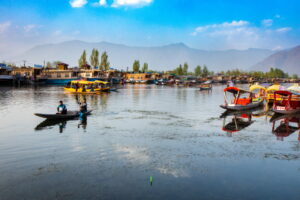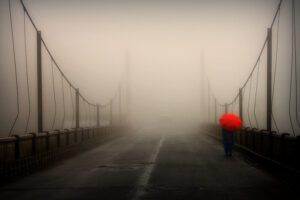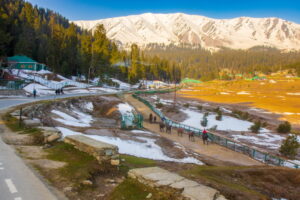Loktak Lake is the face of Manipur’s tourism circuit. If you see one picture of Manipur that immediately attracts you to visit the state, it is probably off Loktak Lake. A vast wetland with perfect ring-shaped structures floating on the water – that’s Loktak Lake for you. Being the largest freshwater lake in the country. Loktak Lake has a vast ecosystem depending on the lake.
The main attraction of this place is the floating grasslands or the phumdis, as called locally. The phumdis are so extensive that an entire national park is located on it, the natural habitat of the endangered Sangai Deer or the “Dancing Deer.” Loktak Lake, with its floating phumdis, wild habitats, diverse vegetation and vast aquatic life, is truly an ecological marvel of northeast India.
Pin the image below to save the post and read it later!!
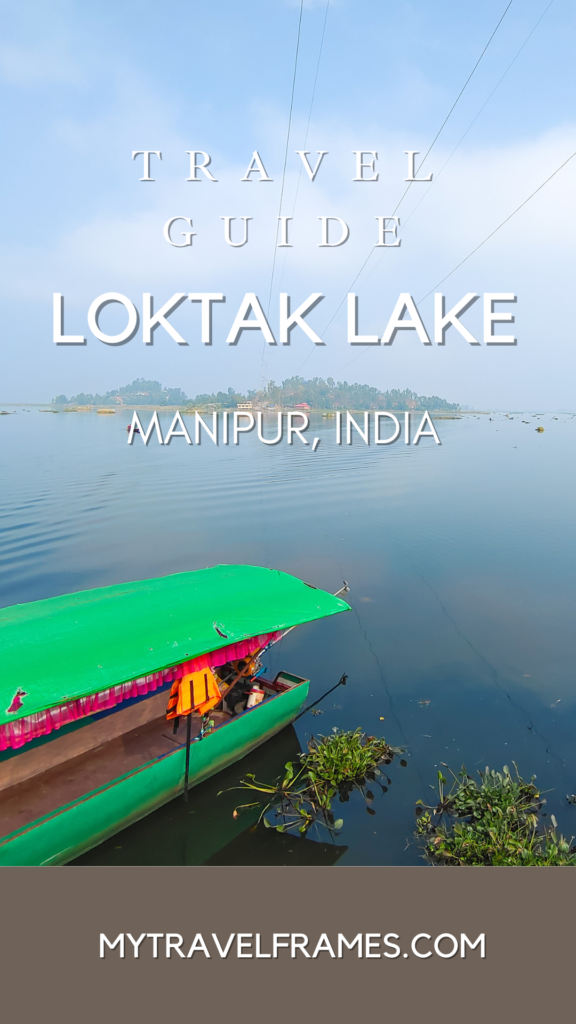
About
Loktak Lake, situated in Manipur in northeast India, is the largest freshwater lake in India and South Asia. The area of the lake is close to 290 sq km and extends to 500 sq km during monsoon. The uniqueness of this lake is in its ecosystem.
A national park is located on the water of Loktak Lake – a floating National Park known as Keibul Lamjao National Park. Nearly 27 square km of the Keibul Lamjao National Park floats on the water of Lokatak Lake. It is the habitat of the endangered Sangai Deer, the state animal of Manipur.

This is possible because of the phumdis, heterogenous mass of vegetation, soil and organic matter at various stages of decomposition. The most extensive stretch of phumdis is at the southeast shore of Loktak Lake, where the Keibul Lamjao National Park is located.
Loktak in Meitei means “the end of the stream.” All the rivers in Imphal Valley eventually drain into Loktak Lake. The principal tributary is the Imphal River which has the largest catchment area and the main river of the Imphal Valley.
Loktak Lake plays a vital role in the economy of Manipur. It is a water source for hydropower generation, irrigation and drinking water supply. More than 50 villages and small towns surround this lake where nearly a hundred thousand people live, and most depend directly on it for their livelihood.
Loktak Lake is home to 230 types of plants, 100 types of birds and 400 types of animals. Apart from the Sangai Deer, Keibul Lamjao National Park shelters sambar deer, barking deer, black bears, wild boars, rhesus monkeys, hoolock gibbons, Indian pythons etc. Loktak Lake is a visual treat for birdwatchers who can find black kite, east Himalayan pied kingfisher, northern hill myna, lesser eastern jungle crow, Burmese pied myna and lesser skylark.

How to reach
Loktak Lake is situated approximately 48 kilometres away from Imphal, the capital of Manipur. It takes less than an hour to reach Loktak Lake from Imphal. The nearest town in Moirang is 10 kilometres from Loktak Lake. You will get shared cabs near Ima Keithel, Imphal, that will take you to Moirang. From Moirang, you can hire an autorickshaw that will take you to your hotel or homestay.
By Air:
The nearest airport to Loktak Lake is Imphal International Airport, about 54 km away. You can take a taxi or private car from the airport to reach the lake.
By Train:
The nearest railway station to Loktak Lake is Dimapur Railway Station, about 215 km away. You can take a taxi or a private car from the railway station to reach the lake. Jiribam railway station is 220 kilometres from Loktak Lake, and you will get cabs from Jiribam to reach Loktak Lake.
By Road:
Loktak Lake is well-connected by road to major cities in Manipur and neighbouring states. You can take a bus or taxi from Imphal or other nearby towns to reach Moirang, the nearest town to Loktak Lake.

Where to stay
The accommodation options near Loktak Lake are limited. The most convenient place to stay beside Loktak Lake is Sendra Park Resort, located on Sendra Hilltop inside Loktak Lake. The rooms have magnificent views of the lake.
This resort is equipped with all basic amenities, and if you want a comfortable place to spend some good time with your family, this should be your first choice. The number of rooms is limited, and one must book the room well in advance, especially during peak season.
Apart from Sendra Resort, a few homestays are beside Loktak Lake, and a couple is inside Loktak Lake on the phumdis. If you want to experience a memorable time with your friends, you can book a homestay inside Loktak Lake, located on a phumdi. Loktak Aquamarine Floating Homestay and Laisoi Farm Homestay are two such places that are very popular among travellers.
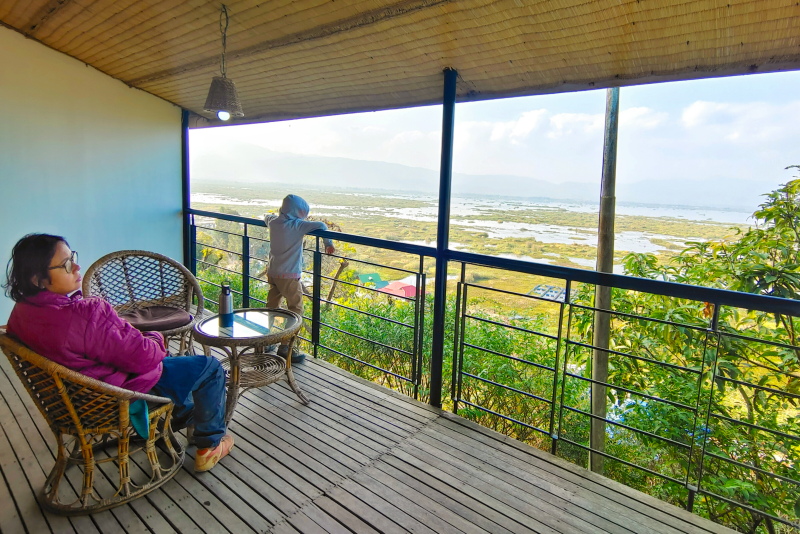
Best time to visit
You can visit Loktak Lake throughout the year. The best time to visit Loktak Lake depends on what you want to see and experience.
The winter months, from November to February, are generally considered the best time to visit Loktak Lake as the weather is pleasant, with temperatures ranging from 5°C to 25°C. Thus making it an ideal time for outdoor activities such as boating, trekking, and bird watching. During this time, you can witness the migratory birds that flock to the lake, and the surrounding hills are covered with lush greenery, making it an excellent time for sightseeing and photography.
The summer months from March to June are also a good time to visit the lake, although the weather can be pretty warm, with temperatures ranging from 15°C to 35°C. During this time, the water level in the lake is at its lowest, making it a good time for boating and exploring the various islands and floating huts on the lake.

The monsoon season from July to September is not the ideal time to visit Loktak Lake as heavy rains can disrupt your travel plans, and the lake can become flooded, making it difficult to navigate. However, during this time, the phumdis look more prominent and beautiful.
Overall, the best time to visit Loktak Lake is during the winter months, followed by the summer months, while the monsoon season is not ideal for a visit.
What is so special about Loktak Lake
Loktak Lake has some unique things that make it an exceptional destination in northeast India. These are the floating islands, a floating national park and the habitat of an endangered animal.
Phumdis – the floating islands
Loktak Lake is the only known lake in the world with floating islands called phumdis, which comprise a combination of vegetation, soil, and organic matter. Phumdis vary in size, from small patches to large islands several kilometres long. They are home to various flora and fauna, including rare and endangered species such as the Sangai deer, found only in Manipur. These phumdis are so strong they can support human settlements, including houses.
The photos of the circular rings seen from the hilltop viewpoints or the flight are athaphums (artificially created phumdis) made by locals for fishing. These are creating problems for the ecosystem of the lake and choking the lake over time.

A floating national park – Keibul Lamjao National Park
It is the only floating national park in the world located on Loktak Lake. The park covered an area of approximately 40 square kilometres and was declared a national park in 1977.
The park is home to several endangered species, including the Sangai, also known as the Manipur brow-antlered deer. Apart from Sangai, the park is also home to other fauna, such as hog deer, otters, and many species of birds. The park is also an essential part of the wetland ecosystem of Loktak Lake, which is the largest freshwater lake in Northeast India.
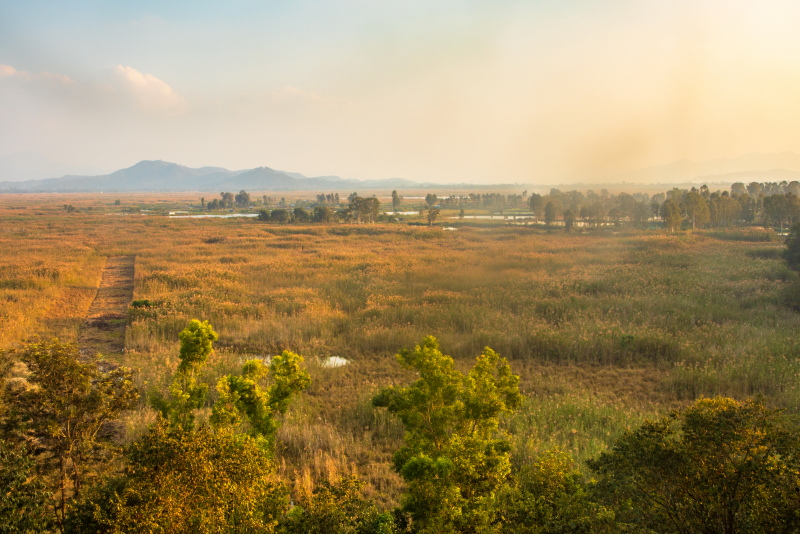
Tourists can enjoy boating and bird watching in the park. The park is open throughout the year, but the best time to visit is from November to March when the weather is pleasant, and migratory birds can be seen.
Read more: Keibul Lamjao National Park | The Only Floating National Park In The World
Sangai deer – an endangered animal
The Sangai deer, also known as the Manipur brow-antlered deer or dancing deer, is a critically endangered subspecies of the Eld’s deer native to the Keibul Lamjao National Park in the Indian state of Manipur. It is the state animal of Manipur and is considered an important cultural and ecological symbol of the region.

The Sangai deer is characterized by its distinctive antlers, which have brow tines that are long and curved. The deer is also known as the “dancing deer”, as it seems to dance when it moves across the phumdis. The phumdis floating on the water trembles when the deer walks, giving the impression that the animal is dancing.
It is endemic to this area and was on the verge of extinction in the 20th century, with only a handful remaining. The population has increased to over 200 individuals thanks to conservation efforts in recent years.
Sangai Festival is celebrated by the Tourism Department of Manipur every year from 21st-30th November. It is celebrated in different parts of the state to promote Manipur as a world-class tourist destination. It showcases Manipur’s arts and culture, handicrafts, handloom, indigenous sports, music and cuisine.
A slice of life from Loktak Lake and the islands on it
There are many islands inside Loktak Lake. These islands are essentially hills that humans inhabit. Among them, Sendra and Thanga islands are located on the southern end, whereas Karang island is located near the central zone. The islands on the south end became attached to the mainland with roads constructed on the phumdis.
Sendra is one of the largest islands on Loktak Lake, which almost became a part of the land with an upscale resort and an army base located on it. Thanga Island is located inside the lake and attached to the mainland with well-maintained roads. It is now a prominent fishing village beside Loktak Lake.
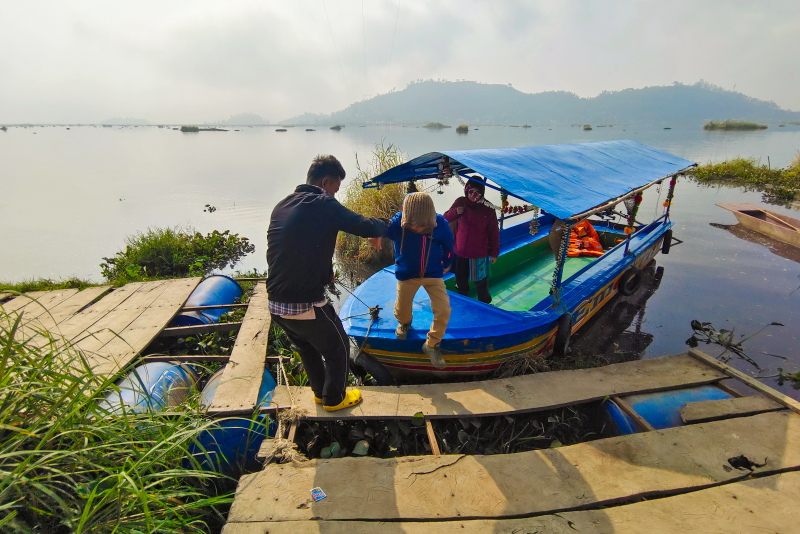
Karang Island is located isolated from the mainland and accessed only by boats. The residents of Karang Island travel across the lake by motorboats from the Ferry Ghat. Many of them also have their dinghy boats to sail across. Reaching Karang Island and spending time there was a pleasant experience.
Karang Island is a hilltop with people residing on it. The lower reaches have houses, farmlands, ponds, shops, a school and a temple. There is a health centre cum rural hospital near the peak. The main livelihood of the people here is farming and fishing.
In monsoon, fishing becomes the main activity when the water submerges the lower reaches, and the farmlands drown. Paddy and some vegetables can be cultivated on the common land beside the lake during winter and summer.
The people here are mainly Hindus. And the temple at the island’s centre is where religious festivals are celebrated yearly.
Karang Island is declared the first cashless island in India, where most residents opt for digital transactions for their daily expenses. Babu Homestay is a homestay that opened recently on Karang Island, where you can stay beside Loktak Lake and live like locals.

Things to do in and around Loktak Lake
Boating on Loktak Lake
Boating on Loktak Lake can be an excellent experience for those who enjoy nature and scenic views. To go boating on Loktak Lake, you must visit the Karang Island Ferry Ghat. There are several options for boating, including motor boats, dinghy boats or paddle boats. Here you can enjoy boating in the central zone of the lake, which is the most beautiful part.
You can watch farmers busy farming by the lakeside and the fishermen fishing near the phumdis. The sunrise and sunset from the boats look mesmerising. These boats usually take tourists from boating on an hourly basis. They usually encircle Karang Island for over an hour. You can also take a ride To Karang Island with the locals and enjoy life on an island on Loktak Lake.
If you opt for boating in Keibul Lamjao national park, you may also spot some of the unique wildlife inhabiting the lake, such as the endangered Sangai deer found only in Manipur. The boats here usually take tourists inside the grasslands of phumdis to spot wild animals. The boating last for 20 minutes usually. There will be a guide with you who will help to identify different types of flora and fauna of the forest.

Visit Keibul Lamjao national park
Keibula Lamjao National Park is located on the southeast shore of Loktak Lake. The park is over 40 square-km area, and two-thirds of the total area is floating on Loktak Lake. That’s what makes this national park a unique place. It was named a wildlife sanctuary in 1966. 11 years later, the sanctuary was awarded a national park status.
If you look at the Park from the watchtower, the entire area looks like a vast grassland with small water pockets in between. It is hard to believe that the whole area is floating on water and part of Loktak Lake. It is possible because of large size phumdis that are merged to form huge floating grasslands.
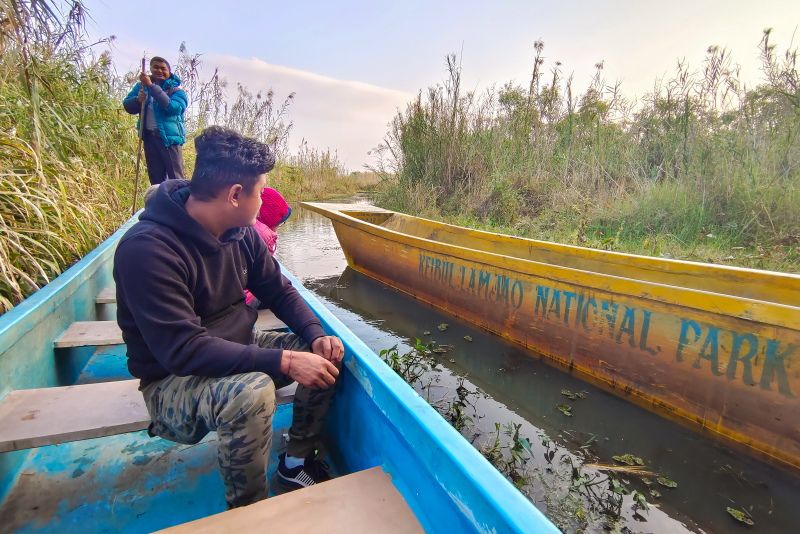
Keibul Lamjao National Park is the natural habitat of endangered Sangai Deer and 400 other animals, and 100 different birds, including migratory birds.
Entry time: 9 am – 6 pm
Entry fee:
- Adult – Domestic/Foreigner – ₹30/₹200;
- Student and children – Domestic/Foreigner – ₹15/₹100;
- Still camera – Domestic/Foreigner – ₹50/₹250;
- video camera – Domestic/Foreigner – ₹1000/₹6000;
- Light vehicle (up to 10 seat capacity) – Domestic/Foreigner – ₹100/₹500
Enjoy a bird’s eye view of Loktak Lake from Chibao Ching
Chibao Ching View Point is one of the popular viewpoints from where visitors can enjoy the stunning lake views. From the Chibai Ching View Point, you can witness the panoramic 360-degree views of Loktak Lake, the largest freshwater lake in Northeast India. The lake is surrounded by lush green hills, floating islands, and dense forests, which make for a breathtaking sight.
You can also see the fisherman’s huts, built on the floating islands, and the colourful boats used for fishing on the lake. The viewpoint is located at an altitude of around 919 meters above sea level, and it offers a clear and unobstructed view of the lake.
Visitors can take a leisurely walk around the viewpoint and enjoy the cool breeze and the serene surroundings. It is also a great place to capture some beautiful photographs of the lake and the surrounding landscape from the watchtower at Chibao Ching.

Entry time: 6 am – 6 pm ( all days)
Entry fee: ₹50
Visit INA War Memorial Museum, and INA headquarter
INA Martye’s Memorial Complex is located in the nearby town of Moirand and is a must-visit for every tourist visiting Loktak Lake. The unity, faith and sacrifice shown by the INA soldiers and their commander Subhash Chandra Bose are one of the most significant periods in the history of the Indian Freedom Movement. And the INA Martyr’s Memorial Complex bears evidence of that glorious past. This is the same place where Col. S A Malik, an INA soldier, hoisted the tricolour flag for the first time in mainland India.
The INA War Museum has photographs, maps and artefacts that portray the courage and sacrifice of INA and Netaji. The rare black and white and colour pictures of Netaji, INA generals and colonels and INA rallies are the main attraction of the museum. There is a life-size colour portrait of Netaji, which also attracts visitors.
The charts, maps showing Netaji’s great escape and advance-withdrawal of Azad Hind Fauz, maps on the battlefield of Imphal and Kohima, Japanese map of Manipur battle plan, letters written by Netaji, pamphlets and handbills written in Bengali and signed by Subhas Chandra Bose are other rare things that one can find in this museum.
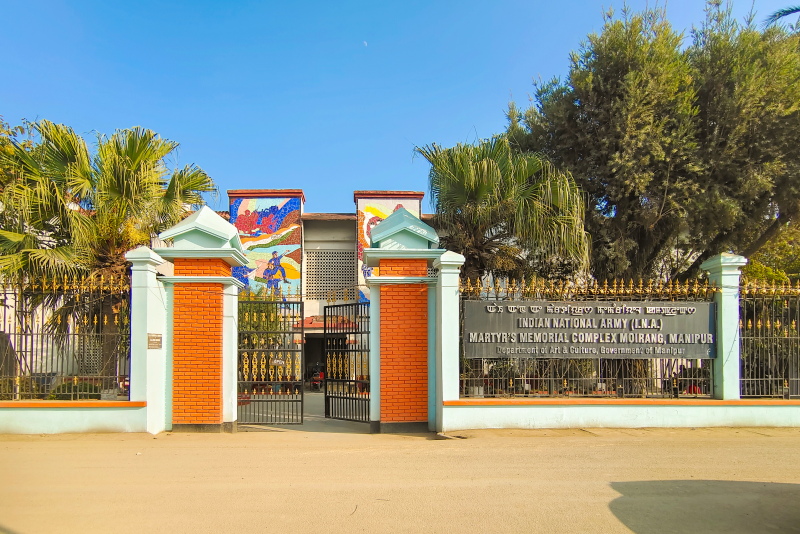
The INA headquarters building is still in Moirang, the only headquarter of INA in India. It was the residence of H Nilmani Singh, a local member of INA who fought against the British Army. This building bears the brunt of machine gun tides and bomb splinters. The marks are still there on the main door and roof.
Read more: INA Martyr’s Memorial Complex And The Only INA Headquarters In India at Moirang, Manipur
Loktak Lake Eco-Tourism
Eco-tourism in Loktak Lake can allow visitors to explore the lake’s natural beauty and learn about the local culture and traditions. Here are some possible activities that could be included in a Loktak Lake eco-tourism experience:
- Boat tours: Visitors can take a guided boat tour around the lake to explore the floating islands, observe wildlife, and learn about the local fishing and agricultural practices.
- Trekking: The surrounding hills offer opportunities for trekking and hiking, with scenic views of the lake and the surrounding landscape.
- Birdwatching: Loktak Lake is home to many species of birds, including migratory birds that visit during the winter months. Visitors can go on guided birdwatching tours to observe these birds and learn about their behaviour and habitat.
- Cultural experiences: Visitors can also learn about the unique culture and traditions of the local communities that live around the lake. This could include visiting traditional villages, interacting with local artisans, and participating in cultural events and festivals.
- Sustainable tourism practices: Eco-tourism activities in Loktak Lake need to be sustainable and environmentally responsible. This could include measures to reduce waste and pollution, promote the conservation of the lake and its wildlife, and support local communities through responsible tourism practices.
Overall, eco-tourism in Loktak Lake has the potential to provide visitors with a unique and authentic travel experience while also supporting conservation and sustainable development in the region.

Book your trip: Resources
- Flight
Use Skyscanner or Google Flights to book your flight.
- Accommodation
Tripadvisor and Agoda are perfect for booking your hotel. If you want to stay in a hostel, then Hostelworld would greatly help you find one at your convenience.
- Travel Insurance
World Nomads is perfect for travel insurance. You can get comprehensive protection from them. Let them take care of unexpected situations while you concentrate on your trip.
- Package Tour and Activities
You can book a package tour from G-Adventures and Viator. They are a reputed company arranging small group tours and customising them per your requirements. You can also use Get Your Guide to book your private transport, city tours, heritage walks, food walks and other experiences like a cooking lesson or a Yoga session.
Disclosure: Some of the links below are affiliate links. You will be directed to another third-party website when you click those links. If you purchase anything via those links, I will earn a referral bonus without any extra cost to you.

